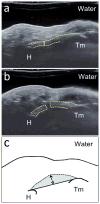Pressure-morphology relationship of a released carpal tunnel
- PMID: 23184493
- PMCID: PMC3836188
- DOI: 10.1002/jor.22271
Pressure-morphology relationship of a released carpal tunnel
Abstract
We investigated morphological changes of a released carpal tunnel in response to variations of carpal tunnel pressure. Pressure within the carpal tunnel is known to be elevated in patients with carpal tunnel syndrome and dependent on wrist posture. Previously, increased carpal tunnel pressure was shown to affect the morphology of the carpal tunnel with an intact transverse carpal ligament (TCL). However, the pressure-morphology relationship of the carpal tunnel after release of the TCL has not been investigated. Carpal tunnel release (CTR) was performed endoscopically on cadaveric hands and the carpal tunnel pressure was dynamically increased from 10 to 120 mmHg. Simultaneously, carpal tunnel cross-sectional images were captured by an ultrasound system, and pressure measurements were recorded by a pressure transducer. Carpal tunnel pressure significantly affected carpal arch area (p < 0.001), with an increase of >62 mm(2) at 120 mmHg. Carpal arch height, length, and width also significantly changed with carpal tunnel pressure (p < 0.05). As carpal tunnel pressure increased, carpal arch height and length increased, but the carpal arch width decreased. Analyses of the pressure-morphology relationship for a released carpal tunnel revealed a nine times greater compliance than that previously reported for a carpal tunnel with an intact TCL. This change of structural properties as a result of transecting the TCL helps explain the reduction of carpal tunnel pressure and relief of symptoms for patients after CTR surgery.
Copyright © 2012 Orthopaedic Research Society.
Figures





Similar articles
-
Changes in carpal tunnel compliance with incremental flexor retinaculum release.J Orthop Surg Res. 2016 Apr 13;11:43. doi: 10.1186/s13018-016-0380-3. J Orthop Surg Res. 2016. PMID: 27074707 Free PMC article.
-
Release of the transverse carpal ligament alone is associated with elevated pressure beneath the distal volar forearm fascia in a cadaver model of carpal tunnel syndrome.J Hand Surg Am. 2007 Dec;32(10):1533-7. doi: 10.1016/j.jhsa.2007.08.020. J Hand Surg Am. 2007. PMID: 18070640
-
Anatomy of the ulnar artery as it relates to the transverse carpal ligament.J Hand Surg Am. 2002 Jan;27(1):101-4. doi: 10.1053/jhsu.2002.30077. J Hand Surg Am. 2002. PMID: 11810622
-
Anatomic variations of the median nerve in the carpal tunnel: a brief review of the literature.Turk Neurosurg. 2011;21(3):388-96. doi: 10.5137/1019-5149.JTN.3073-10.1. Turk Neurosurg. 2011. PMID: 21845577 Review.
-
The carpal tunnel syndrome: Part II.Am Surg. 1992 Feb;58(2):77-81. Am Surg. 1992. PMID: 1550309 Review.
Cited by
-
Morphological and positional changes of the carpal arch and median nerve during wrist compression.Clin Biomech (Bristol). 2015 Mar;30(3):248-53. doi: 10.1016/j.clinbiomech.2015.01.007. Epub 2015 Jan 31. Clin Biomech (Bristol). 2015. PMID: 25661267 Free PMC article.
-
Ultrasound elastography for carpal tunnel pressure measurement: A cadaveric validation study.J Orthop Res. 2018 Jan;36(1):477-483. doi: 10.1002/jor.23658. Epub 2017 Aug 14. J Orthop Res. 2018. PMID: 28731271 Free PMC article.
-
Biomechanical interaction between the transverse carpal ligament and the thenar muscles.J Appl Physiol (1985). 2013 Jan 15;114(2):225-9. doi: 10.1152/japplphysiol.01273.2012. Epub 2012 Dec 6. J Appl Physiol (1985). 2013. PMID: 23221960 Free PMC article.
-
Thickness and Stiffness Adaptations of the Transverse Carpal Ligament Associated with Carpal Tunnel Syndrome.J Musculoskelet Res. 2016 Dec;19(4):1650019. doi: 10.1142/S0218957716500196. Epub 2017 Feb 20. J Musculoskelet Res. 2016. PMID: 28824216 Free PMC article.
-
Finite element analysis for transverse carpal ligament tensile strain and carpal arch area.J Biomech. 2018 May 17;73:210-216. doi: 10.1016/j.jbiomech.2018.04.005. Epub 2018 Apr 12. J Biomech. 2018. PMID: 29678419 Free PMC article.
References
-
- Kline SC, Moore JR. The transverse carpal ligament. An important component of the digital flexor pulley system. J Bone Joint Surg Am. 1992;74:1478–1485. - PubMed
-
- Garcia-Elias M, An KN, Cooney WP, 3rd, et al. Stability of the transverse carpal arch: an experimental study. J Hand Surg Am. 1989;14:277–282. - PubMed
-
- Fuss FK, Wagner TF. Biomechanical alterations in the carpal arch and hand muscles after carpal tunnel release: a further approach toward understanding the function of the flexor retinaculum and the cause of postoperative grip weakness. Clin Anat. 1996;9:100–108. - PubMed
-
- Kung J, Budoff JE, Wei ML, et al. The origins of the thenar and hypothenar muscles. J Hand Surg Br. 2005;30:475–476. - PubMed
-
- Richman JA, Gelberman RH, Rydevik BL, et al. Carpal tunnel syndrome: morphologic changes after release of the transverse carpal ligament. J Hand Surg Am. 1989;14:852–857. - PubMed
Publication types
MeSH terms
Grants and funding
LinkOut - more resources
Full Text Sources
Medical
Research Materials

